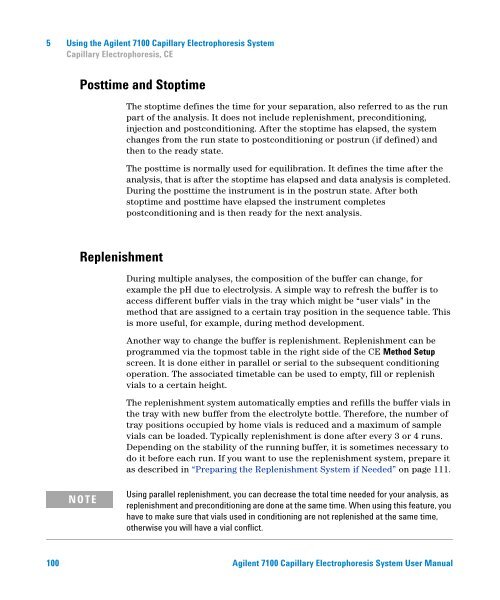Introduction to the Agilent 7100 Capillary Electrophoresis System
Introduction to the Agilent 7100 Capillary Electrophoresis System
Introduction to the Agilent 7100 Capillary Electrophoresis System
Create successful ePaper yourself
Turn your PDF publications into a flip-book with our unique Google optimized e-Paper software.
5 Using <strong>the</strong> <strong>Agilent</strong> <strong>7100</strong> <strong>Capillary</strong> <strong>Electrophoresis</strong> <strong>System</strong><br />
<strong>Capillary</strong> <strong>Electrophoresis</strong>, CE<br />
Posttime and S<strong>to</strong>ptime<br />
The s<strong>to</strong>ptime defines <strong>the</strong> time for your separation, also referred <strong>to</strong> as <strong>the</strong> run<br />
part of <strong>the</strong> analysis. It does not include replenishment, preconditioning,<br />
injection and postconditioning. After <strong>the</strong> s<strong>to</strong>ptime has elapsed, <strong>the</strong> system<br />
changes from <strong>the</strong> run state <strong>to</strong> postconditioning or postrun (if defined) and<br />
<strong>the</strong>n <strong>to</strong> <strong>the</strong> ready state.<br />
The posttime is normally used for equilibration. It defines <strong>the</strong> time after <strong>the</strong><br />
analysis, that is after <strong>the</strong> s<strong>to</strong>ptime has elapsed and data analysis is completed.<br />
During <strong>the</strong> posttime <strong>the</strong> instrument is in <strong>the</strong> postrun state. After both<br />
s<strong>to</strong>ptime and posttime have elapsed <strong>the</strong> instrument completes<br />
postconditioning and is <strong>the</strong>n ready for <strong>the</strong> next analysis.<br />
Replenishment<br />
During multiple analyses, <strong>the</strong> composition of <strong>the</strong> buffer can change, for<br />
example <strong>the</strong> pH due <strong>to</strong> electrolysis. A simple way <strong>to</strong> refresh <strong>the</strong> buffer is <strong>to</strong><br />
access different buffer vials in <strong>the</strong> tray which might be “user vials” in <strong>the</strong><br />
method that are assigned <strong>to</strong> a certain tray position in <strong>the</strong> sequence table. This<br />
is more useful, for example, during method development.<br />
Ano<strong>the</strong>r way <strong>to</strong> change <strong>the</strong> buffer is replenishment. Replenishment can be<br />
programmed via <strong>the</strong> <strong>to</strong>pmost table in <strong>the</strong> right side of <strong>the</strong> CE Method Setup<br />
screen. It is done ei<strong>the</strong>r in parallel or serial <strong>to</strong> <strong>the</strong> subsequent conditioning<br />
operation. The associated timetable can be used <strong>to</strong> empty, fill or replenish<br />
vials <strong>to</strong> a certain height.<br />
The replenishment system au<strong>to</strong>matically empties and refills <strong>the</strong> buffer vials in<br />
<strong>the</strong> tray with new buffer from <strong>the</strong> electrolyte bottle. Therefore, <strong>the</strong> number of<br />
tray positions occupied by home vials is reduced and a maximum of sample<br />
vials can be loaded. Typically replenishment is done after every 3 or 4 runs.<br />
Depending on <strong>the</strong> stability of <strong>the</strong> running buffer, it is sometimes necessary <strong>to</strong><br />
do it before each run. If you want <strong>to</strong> use <strong>the</strong> replenishment system, prepare it<br />
as described in “Preparing <strong>the</strong> Replenishment <strong>System</strong> if Needed” on page 111.<br />
NOTE<br />
Using parallel replenishment, you can decrease <strong>the</strong> <strong>to</strong>tal time needed for your analysis, as<br />
replenishment and preconditioning are done at <strong>the</strong> same time. When using this feature, you<br />
have <strong>to</strong> make sure that vials used in conditioning are not replenished at <strong>the</strong> same time,<br />
o<strong>the</strong>rwise you will have a vial conflict.<br />
100 <strong>Agilent</strong> <strong>7100</strong> <strong>Capillary</strong> <strong>Electrophoresis</strong> <strong>System</strong> User Manual
















